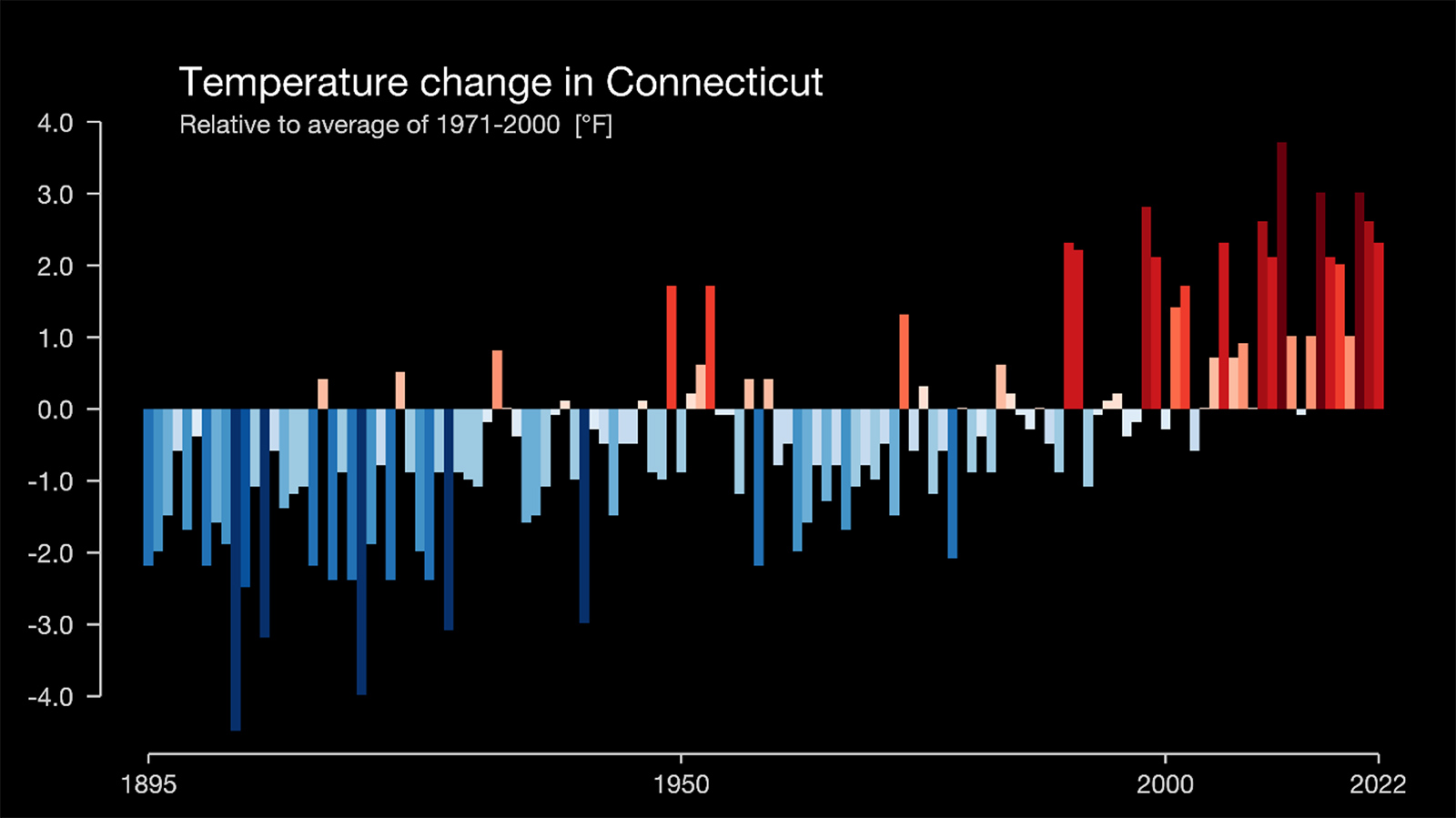Climate Change
Long Island Sound is already experiencing the impacts of climate change, including rising temperatures, sea level rise, stronger storms, and shifting ecosystems. However, through conservation, restoration, and sustainable practices, we can work together to mitigate these effects and build a more resilient future.
Major Climate Change Effects on Long Island Sound
Climate change is already affecting Long Island Sound, bringing changes that impact both people and wildlife. Some of the key effects include
- Hotter temperatures: By 2050, the number of days over 90°F is expected to rise sharply, especially in cities where buildings and pavement trap heat. A “warming stripe” graphic showing Connecticut’s temperature trends highlights this shift, with recent years turning from blue to red as average temperatures continue to rise.

Credit: Professor Ed Hawkins, University of Reading. #ShowYourStripes
- Warming Waters: The Sound’s water temperature has increased by over 6.6% since 1960, with winter temperatures rising even faster. This can stress marine life and change the makeup of fish populations. As waters warm, some fish and shellfish are moving to cooler areas, affecting local fisheries and the balance of marine ecosystems.
- Rising Sea Levels: Connecticut’s coastline could see sea levels rise by about 20 inches by 2050 (O’Donnell 2019), leading to more frequent flooding and shoreline erosion.
- More Extreme Storms: Stronger hurricanes and heavier rainfall are causing bigger storm surges and inland flooding, damaging homes, infrastructure, and habitats.
- More Extreme Rainfall: Heavy rainstorms are becoming more common in Connecticut, leading to increased runoff that can pollute waterways and overwhelm drainage systems. After heavy rains, poor water quality often forces beach closures and limits shellfish harvesting. Aging stormwater and wastewater systems struggle to handle the volume of water, increasing the risk of flooding and infrastructure damage.
- Spread of Invasive Species: Warmer temperatures and shifting rainfall patterns are helping non-native plants and animals spread, often harming native species.
The Cost of Climate Disasters
Coastal communities enjoy many benefits, but they also face growing risks from climate-related disasters. Since 2018, Connecticut has endured 12 coastal climate-related disasters since 2018, each causing over a billion dollars in damages (NCEI). Between 2011 and 2021, the state required $532 million in federal aid to recover from extreme weather events (Atlas of Disaster).
Rising sea levels, stronger storms, and flooding are putting homes, roads, and local businesses at risk. To reduce future costs and protect communities, investments in stronger infrastructure, better planning, and climate adaptation strategies are essential.
Taking Action – Collective Solutions
The realities of climate injustice can feel overwhelming at times, but it is important to remember that you are not alone and we can join with others to make an impact. Addressing climate change requires systemic solutions, corporate accountability, and strong policies. While individual actions are valuable, large-scale impact comes from collective efforts. Here’s how we can work together:
- Advocate for Policy Change: Support climate policies that reduce carbon emissions, promote renewable energy, and protect vulnerable communities.
- Engage with Local Government: Attend town meetings, comment on infrastructure projects, and support municipal climate action plans.
- Support Sustainable Businesses: Choose to buy from companies that prioritize environmental responsibility and sustainability.
- Invest in Resilient Infrastructure: Encourage funding for nature-based flood solutions, green stormwater management, and energy-efficient public buildings.
- Join Environmental Organizations: Get involved with local climate action groups or conservation initiatives (like The Land Trust of West Haven!) to amplify collective impact.
- Push for Corporate Accountability: Demand that large polluters reduce emissions and transition to cleaner practices.
What You Can Do
While systemic change is necessary, personal choices also make a difference in reducing emissions and promoting sustainability:
- Reduce Energy Use: Switch to LED bulbs, unplug electronics when not in use, and improve home insulation to lower energy consumption.
- Use Renewable Energy: Transition to solar or wind power for your home or advocate for community renewable energy programs.
- Limit Single-Use Plastics: Opt for reusable bags, bottles, and containers to reduce plastic waste.
- Eat Sustainably: Reduce meat and dairy consumption, support local farms, and compost food scraps to lower carbon emissions.
- Reduce Transportation Emissions: Walk, bike, carpool, or use public transit to cut down on fossil fuel use.
- Plant Native Trees and Gardens: Trees absorb carbon dioxide and provide shade, while native plants support pollinators and local wildlife.
- Prepare for Climate Events: Have an emergency plan, store essential supplies, and stay informed about local climate risks.
By taking action now—both individually and collectively—we can protect Long Island Sound and ensure a more resilient future for generations to come.
Resources & Citations
Fifth National Climate Assessment | USGCRP – A comprehensive scientific report detailing climate trends, impacts, and solutions across the U.S., including the Northeast region.
Neighborhoods at Risk | Headwaters Economics – An interactive tool that helps communities identify areas vulnerable to climate change and develop strategies to build resilience.
National Climate Report | Annual 2024 | National Centers for Environmental Information (NCEI) – A climate report summarizing trends in temperature, sea level rise, and extreme weather events across the U.S.
NOAA National Centers for Environmental Information, Monthly National Climate Report for Annual 2024, published online January 20241, retrieved on February 9, 2025 from https://www.ncei.noaa.gov/access/monitoring/monthly-report/national/202413. DOI: https://www.ncei.noaa.gov/access/metadata/landing-page/bin/iso?id=gov.noaa.ncdc:C00674
#ShowYourStripes | Institute for Environmental Analytics – An interactive website where you can look up visual temperature trend information for regions around the globe.
Water Temperature | Long Island Sound Study – Provides data on rising water temperatures in Long Island Sound and their effects on marine life and local ecosystems.
Historical Hurricane Tracks Tool | NOAA – An interactive map that allows users to explore past hurricane paths and understand storm trends in different regions, helping communities prepare for future extreme weather events.
Storm Surge Inundation Map | EPA – A mapping tool that visualizes areas at risk of storm surge flooding, helping communities plan for extreme weather and coastal resilience.
Connecticut – State Climate Summaries 2022 | NOAA
Runkle, J., K.E. Kunkel, S.M. Champion, D.R. Easterling, B.C. Stewart, R. Frankson, W. Sweet, and J. Spaccio, 2022: Connecticut State Climate Summary 2022. NOAA Technical Report NESDIS 150-CT. NOAA/NESDIS, Silver Spring, MD, 6 pp.
Extreme Precipitation in New York & New England | Northeast Regional Climate Center (NRCC) & Natural Resources Conservation Service (NRCS) – An interactive web tool for analyzing extreme rainfall.
Coastal Hazards | CT DEEP – Learn about the effects of coastal hazards in Connecticut, actions and strategies that managers can take, and access local mapping and visualization tools for assessing environmental conditions.
NOAA Billion-Dollar Weather and Climate Disasters Database | National Centers for Environmental Information (NCEI) – A resource tracking major climate-related disasters and their financial impacts in the U.S
Atlas of Disaster | Rebuild by Design – A report analyzing the economic and social consequences of climate change disasters.
The Existential Toolkit for Climate Justice Educators – An open-access database of tools and resources for addressing emotional difficulties associated with climate education.
What If We Get It Right? – Find more ideas for climate action in this book and website by Ayana Elizabeth Johnson.
Climate Action Plan – If you don’t know where to start, this guide is a great way to define where and how you can best contribute.
